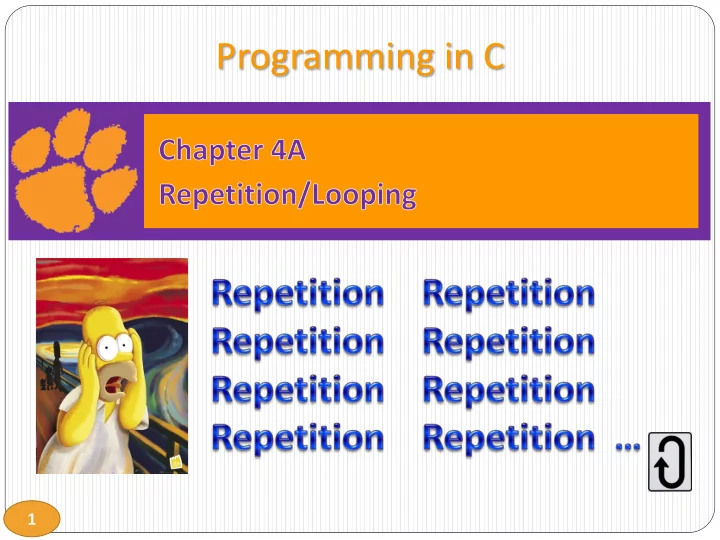

Programming in C 1
Example 1 What if we want to process three different pairs of integers? 2
Example 2 One solution is to copy and paste the necessary lines of code. Consider the following modification: What if you wanted to process four sets? Five? Six? …. 3
Processing an arbitrary number of pairs We might be willing to copy and paste to process a small number of pairs of integers but How about 1,000,000 pairs of integers? The solution lies in mechanisms used to control the flow of execution In particular, the solution lies in the constructs that allow us to instruct the computer to perform a task repetitively 4
Repetition (Looping) Use looping when you want to execute a block of code several times Block of code = Body of loop C provides three types of loops while statement 1 Most flexible No ‘restrictions’ for statement 2 Natural ‘counting’ loop do-while statement 3 Always executes body at least once 5
The while Repetition Structure Repetition structure Programmer specifies Condition under which actions will be executed Actions to be repeated Psuedocode While there are more items on my shopping list Purchase next item and cross it off my list while loop repeated As long as condition is true Until condition becomes false 6
The while Repetition Structure • The condition is tested false condition • If the condition is true, the loop body true is executed and the condition is loop body retested. • When the condition is false, the loop is exited. next stmt 7
1 The while Repetition Structure Syntax: while (expression) basic block Expression = Condition to be tested Resolves to true or false Basic Block = Loop Body Reminder – Basic Block: Single statement or Multiple statements enclosed in braces 8
Loop Control Variable (LCV) The loop control variable is the variable whose value controls loop repetition. For a while loop to execute properly, the loop control variable must be declared initialized tested updated in the body of the loop in such a way that the expression/condition will become false If not we will have an endless or infinite loop 9
Counter-Controlled Repetition Requires: Counter variable , LCV, initialized to beginning value 1. Condition that tests for the final value of the counter 2. (i.e., whether looping should continue) Constant increment (or decrement) by which the 3. control variable is modified each time through the loop Definite repetition Loop executes a specified number of times Number of repetitions is known 10
Example 3 EXECUTION CHART count count<5 repetition 0 true 1 1 true 2 2 true 3 3 true 4 4 true 5 5 false 11
Loop Pitfalls Enter value or zero to end: 2 What is wrong with my program? It just sits there! 12
Loop Pitfalls: Misplaced semicolon Notice the ‘;’ after the while condition! Body of loop is between ) and ; Result here: INFINITE LOOP! Ctrl-c = Kill foreground process 13
The for Repetition Structure A natural 'counting' loop Steps are built into for structure! 1. Initialization initialization 2. Loop condition test 3. Increment or decrement false condition true loop body … increment next stmt 14
Review: Assignment Operators Statements of the form variable = variable operator expression; can be rewritten as variable operator= expression; Examples of assignment operators: a += 5 (a = a + 5) a -= 4 (a = a - 4) b *= 5 (b = b * 5) c /= 3 (c = c / 3) d %= 9 (d = d % 9) 15
Review: Pre-increment operator Pre-increment operator: ++n i) Stand alone: add 1 to n If n equals 1, then after execution of the statement the value of n will be 2. ii) In an expression: Add 1 to n and then use the new value of n in the expression. If n is initially 1, the above statement will print the value 2. After execution of printf, n will have the value 2. 16
Review: Post-increment operator Pre-increment operator: n++ i) Stand alone: add 1 to n If n equals 1, then after execution of the statement the value of n will be 2. ii) In an expression: Use the value of n in the expression and then add 1 to n. If n is initially 1, the above statement will print the value 1 and then add 1 to n. After execution, n will have the value 2. 17
Pre- and Post-decrement operator Pre- and post-decrement operators, --n, n-- , behave in a similar manner Use caution when using in an expression Do not use unless you know what you are doing! 18
2 The for Repetition Structure Syntax: for (initialization; test; increment) basic block 19
for loop example Prints the integers from one to ten 20
for Loop Example How many times does loop body execute? 21
for Loop Example How many times does loop body execute? Bite 1 -- Yum! Bite 2 -- Yum! Bite 3 -- Yum! 22
The do-while Repetition Structure The do-while repetition structure is similar to the while structure Condition for repetition tested after the body of the loop is executed loop body true condition false 23
3 The do-while Repetition Structure Syntax: do { statements } while ( condition ); 24
The do-while Repetition Structure Example Prints the integers from 1 to 10 25
The do-while Repetition Structure Example Makes sure that the user enters a valid weight 26
The break Statement break Causes immediate exit from a while , for , do/while or switch structure We will use the break statement only to exit the switch structure! 27
The continue Statement continue Control passes to the next iteration We will not use the continue statement! 28
Programming in C T H E T H E E N D N D 29
Recommend
More recommend